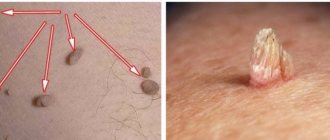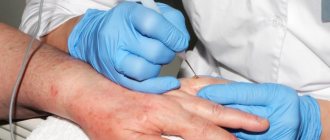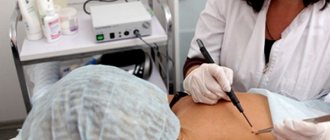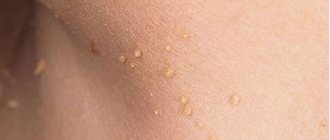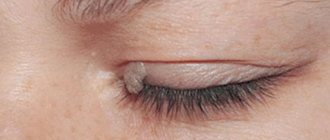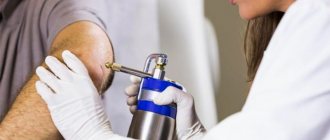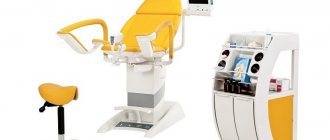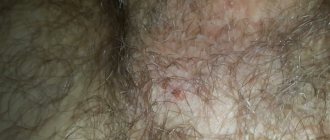Coagulation is a process of mechanical action on living tissues, during which a certain number of cells of these tissues are subjected to controlled destruction. Coagulation is also called cauterization. It is applied to blood vessels, skin neoplasms (condylomas, papillomas, moles), and organ tissues.
One of the ways to carry out such cauterization is electrocoagulation, that is, exposure of tissues to electricity. At the point of contact of the electrode, a high resistance of the skin occurs, which causes the temperature in the skin cells to rise significantly, they become dehydrated and die.
How dangerous are papillomas for humans?
Papillomas can form on the skin and mucous membranes, causing a person not only a cosmetic defect, but also many other troubles. The main ones include the following:
- Psychological discomfort. Papillomas can be localized on open areas of the body, for example, on the arms, face, neck, etc. At the same time, many people associate their presence with something unkempt, sick, etc. When meeting a person with such growths, a negative first impression is formed.
- Constant traumatization . The presence of papillomas on parts of the body that are subject to frequent damage can cause inflammation and other changes. For example, in the collar cuff area, in the armpit, etc.
- You can infect others. A person who is a carrier of such growths is a source of the virus for others. This is especially true for people with weakened immune systems, for example, pregnant women, after illness, etc. Even a simple handshake can cause infection to another person.
- Genital papillomatosis brings psychological problems to a woman in her intimate life, and also increases the risk of infection of the baby in the event of a natural birth.
- Malignancy. Some papillomas can eventually develop into cancer or provoke it.
We recommend reading about electrocoagulation of moles. You will learn about the advantages of the method, indications and contraindications for its implementation, results, and possible complications. And here is more information about electrocoagulation of blood vessels for rosacea.
Will there be any marks left on the skin?
When removing small and medium-sized tumors, we can say with confidence: no, there will be no noticeable scars on the skin. Soon you will simply forget about the mole, wart or other small detail that spoiled your mood.
If the neoplasm is large enough, a light spot devoid of pigment may remain on the skin - but over time, this too will pass.
Various benign skin neoplasms in the form of nevi, hemangiomas or papillomas, especially when located on visible areas of the skin, are not only an aesthetic defect, but over time can lead to significant changes in health:
- pathological growth with an increase in size;
- germination into the underlying layers of the skin;
- ulceration;
- the addition of a secondary infection (fungal or microbial flora);
- malignancy (malignant degeneration).
Therefore, at a certain point, there is a need to get rid of this unpleasant formation.
Contraindications for removal
Many people make the decision to remove papillomas. But before the procedure, you should familiarize yourself with the list of conditions when the procedure is generally contraindicated or should be temporarily postponed. The main red flags include the following:
- Malignant formations at the site of intended treatment.
- Blood clotting disorders. In this case, any manipulations can be complicated by serious bleeding.
- Tendency to keloid scars. A more significant tissue defect may form at the site of papilloma removal.
- Inflammation in the treatment area.
- Exacerbation of any diseases, for example, ARVI, etc.
- Allergic manifestations to the anesthetic used at the injection site.
Types of impact
The considered method of influencing living tissue with high-frequency electric current consists of several types of action, each of which is an integral part of the procedure and ensures its high efficiency. During electrocoagulation, the following effect occurs on the skin when papillomas, condylomas, small vessels and a mesh of them form on it:
- physico-chemical effect , which breaks some bonds in the skin layer;
- thermal - the action of high temperatures causes a burn, which allows you to separate the pathological tissue from healthy skin;
- electro-dynamic , which has a sharp tearing effect on tissues of a pathological nature. It is carried out by heating under the influence of the temperature of blood, lymph, intercellular fluid;
- a biological effect is observed when undamaged skin tissue is irritated, with an increase in the rate of their regeneration, which is especially important for speedy healing after the procedure.
The effect of high-frequency electric current on living tissue is a serious procedure that requires qualifications and practical experience from the specialist performing it. Therefore, electrocoagulation should be performed only in specialized clinics.
Benefits of electrocoagulation
Electrocoagulation has undoubted advantages over other methods of removing such formations. These include the following:
- Fast execution, the whole procedure takes about 10-15 minutes.
- Can be used at any age, with any skin type.
- The electrocoagulator can be adjusted according to the strength and frequency of current supply. This way you can adjust the depth of exposure for formations of different sizes.
- The risk of bleeding is minimal, since simultaneously with the removal of the formation, all blood vessels in the lesion are cauterized.
- The removed papilloma can be subsequently subjected to histological examination. This is impossible, for example, with laser exposure or cryodestruction.
- Compared to other methods of removing papillomas, electrocoagulation is a relatively cheap and accessible method.
Disadvantages of the method
Carrying out electrocoagulation requires certain skills and knowledge. If you ignore the basic recommendations for the procedure and management of the postoperative period, various complications may arise. The main disadvantages of the method include the following:
- After removal of large and deeply located formations, there is a high probability of subsequent formation of rough scars. This largely depends on the individual characteristics of the organism.
- If the electric current is not applied at a sufficient depth, there is a risk of recurrence of papillomas.
- If you do not follow wound care recommendations, a pigment spot may form at the site of removal.
- Electrocoagulation requires pain relief, since without it there is always at least discomfort.
- After electrocoagulation, wounds take a slightly longer time to heal than after laser or exposure to liquid nitrogen. This is due to the mechanism of action and depends on the depth of tissue damage and the size of the papilloma.
How does the wound heal after removal of papilloma by electrocoagulation?
Video on topic
Among the shortcomings of the skin, warts and papillomas occupy a special place. Seemingly unremarkable at first glance, these formations are fraught with a real danger to the body. In addition to aesthetic flaws, growths can develop into a malignant neoplasm. To eliminate the risk of possible relapses, most doctors recommend the use of laser treatment methods. Electrocoagulation of papillomas is a method widely used in medicine and cosmetology.
Method of removing papillomas by electrocoagulation
No special preparation is required for electrocoagulation. As a rule, there is no need even for routine tests - urine, blood, etc.
Most often, electrocoagulation is performed under local anesthesia. Before removing the papilloma itself, the doctor selects the most suitable attachment for removing the formation. This can be a loop, an electrode with a thickening at the end, or in the form of a scalpel. Several can be used in one procedure.
After treating the affected area, the specialist “cuts off” the part of the papilloma protruding above the surface of the skin. The tissues are subsequently sent for histological examination. If the papilloma goes deep into the layers of the skin, it burns out from there. It is the quality of removal of all “roots” that will avoid recurrence of the pathology in the future.
The wound is treated and a bandage is applied.
To learn how papillomas are removed using electrocoagulation, watch this video:
Stages of the procedure
To carry out the electrocoagulation technique, no preliminary preparation of the patient is required. However, exposure to high temperatures on body tissue is a rather painful process that requires local anesthesia. Therefore, the only preparatory point here is the use of preliminary local anesthesia of the nearby skin.
The procedure itself usually takes only a few minutes. If there are several neoplasms, they do not have a very “convenient” localization or a dense structure closely adjacent to the skin, then they are burned out in layers. In this case, it may take a little longer. In some situations, electrocoagulation is not limited to one session.
Is one time enough?
Sometimes even one session of electrocoagulation is enough to radically remove a papilloma or even several in one place. Usually these are small formations, “on a stalk”.
In other cases, you will have to undergo a course of treatment, sometimes even with the addition of medications - antiviral, immunomodulatory, etc.
For example, this is possible in the following moments:
- with deeply located papillomas on a flat base;
- with multiple formations;
- in case of recurrence of papilloma at the site of removal.
Processing after removal
After any operation, including after electrocoagulation, it is important to properly care for the wound to prevent complications. The total healing time is 7 - 10 days.
The recommendations are as follows:
- Immediately after removing the papilloma, a bandage (plaster, etc.) is applied to the wound. It should be replaced 1-2 times a day.
- The wound should be treated 2-3 times a day with a solution of Chlorhexidine, Miramistin or another antiseptic.
- Under no circumstances should you tear off the scabs from the wound, this will lead to the formation of pigment spots in the future and slow down healing.
- It is strictly forbidden to wet the removal site. This will significantly increase the risk of infection.
- So that in the future the site of the former papilloma does not differ from the surrounding tissues, i.e. there were no pigment spots, until final healing it should be protected from the following:
- Exposure to ultraviolet rays (tanning, including in a solarium).
- Do not apply foundation, scrubs, alkalis or other chemicals to the skin in this area.
- There is no need to overdo it when carrying out hygienic procedures when treating with pumice stone, washcloth, etc.
- It is useful to treat the removal site with vitamin E, A after the crusts fall off on their own. Various creams (for example, Dermatix) are also used to prevent the formation of age spots on the skin.
How to remove a scar
To avoid the appearance of scars after mole removal, you need to contact experienced specialists, and not a beauty salon. If the procedure is carried out correctly, then the path to restoring the epidermis will pass without consequences.
A colloidal scar after mole removal is a skin defect in which rapid growth of connective tissue occurs. A colloid (keloid) defect is different from a scar formed due to infection. For each patient, the doctor uses an individual scheme to restore the smoothness of the skin. To improve tissue regeneration, treatment is prescribed:
- smoothing ointments (Contractubex);
- injection of corticosteroids into the atrophic scar;
- physiotherapeutic procedures;
- cosmetic grinding of the skin surface;
- at the initial stage - a scar bandage with absorbable agents.
To speed up the rehabilitation process, you need to follow all the doctor’s recommendations.
Complications that may occur
After electrocoagulation and during it, various complications are possible. Most often you encounter the following:
- Scars after removal of papillomas
Bleeding . It usually develops immediately after the procedure or within a day or two after. - An allergic reaction to both the anesthetic and adhesive plaster, wound treatment products, etc.
- Suppuration occurs when an infection occurs due to improper wound care, soaking, etc.
- Formation of a rough scar or pigment spot at the site of removal.
- Recurrence of papilloma with incomplete excision . Most often this happens with deeply located formations.
Recommendations
Since electrocoagulation entails damage to the skin, care should be taken to restore it as quickly as possible. Raising the body's immunity, complete preliminary cure of infectious, viral and bacterial lesions of the body, as well as regular replenishment of it with vitamins and essential minerals will increase the healing rate of the epidermis and restore its healthy appearance.
An important point in increasing the effectiveness of such an effect and eliminating the risk of side effects should be considered a preliminary consultation with a dermatologist, who will take into account the individual characteristics of the skin, help monitor the course of the operation and draw up the most effective recovery plan.
Price
The price for electrocoagulation depends not only on the clinic and city, but also on the following points:
- number and size of papillomas;
- location of the papilloma (more expensive in the eye area - eyelids, etc.);
- the need for subsequent histological examination.
Removing a papilloma up to 2 mm in diameter without subsequent analysis of the formation will cost about 200 - 300 rubles. From 3 mm or more - 500 - 600 rubles. Histological examination costs about 1000 - 1500 rubles.
Often there are promotions and discounts for the removal of several papillomas at once.
We recommend reading about laser wart removal. You will learn about the benefits of laser, indications and contraindications for this procedure, and the method of its implementation. And here is more information about wound care after laser wart removal.
Reviews
The implementation of such a procedure for removing tumors as electrocoagulation is quite fast due to the simplicity of the specialist’s actions and the absence of the need to prepare the patient for its implementation. Numerous reviews about this type of surgical intervention indicate a high degree of effectiveness, the absence of possible complications after the procedure, as well as ease of implementation.
Patients note the affordability of the procedure. The price of electrocoagulation is more affordable for most patients compared to laser skin treatment, and it is less painful. The rapid restoration of the treated skin and the absence of marks on the skin after it are also considered by many who have already used it to remove various skin defects as an advantage of this procedure.
Alternative Methods
Electrocoagulation can be replaced by other methods. Each of them has its own advantages and disadvantages in a given situation. The most popular and effective include the following:
- Laser removal . The main advantages of the method include painlessness, bloodlessness of the procedure, and the possibility of excision of formations of different sizes and depths.
- Cryodestruction – exposure to liquid nitrogen. This is a kind of “freezing” of tissues with their subsequent destruction.
- Surgical intervention is the traditional removal of various formations, not just papillomas.
Electrocoagulation is an effective and affordable way to remove tumor-like structures. The method can also be used to combat papillomas. You should take an individual approach to the choice of removal tools and follow all healing recommendations. This way you can minimize the risks of developing complications and unpleasant consequences.
Similar articles
- Electrocoagulation of moles: how is removal done on...
Perhaps electrocoagulation of moles is one of the safest and most inexpensive methods of removal. How is the removal procedure performed on the face and body? What are some important tips for after care? Are there any negative consequences? Advantages of the method and comparison with a surgical solution to the problem. Read more - Electrocoagulation of blood vessels on the face and legs...
Electrocoagulation of blood vessels will help get rid of rosacea or unsightly mesh on the face and legs. One of the first techniques, it remains quite effective and accessible today. Read more
- Laser removal of warts on the face, feet, hands...
The laser wart removal procedure has become one of the safest and most affordable. With its help you can get rid of growths on the hands, feet, face, flat and plantar warts, papillomas. Read more
- Surgical removal of moles: how long does it take...
Surgery or surgical removal of moles has virtually no contraindications. The consequences are also minimal. It is worth knowing how long the operation lasts, how to care for the suture, and whether there will be a scar afterwards. Read more
